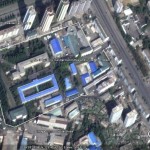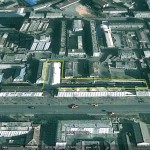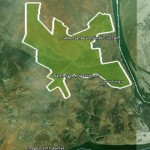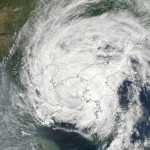
Pictured Above (Google Earth): WPK Building No. 3 compound (Third Building) mentioned below. See in Google Maps here.
Andrei Lankov has a great article in the Korea Times on the WPK’s naming conventions. I have attached the article below and supplemented it with related material taken from Helen-Louise Hunter’s Kim Il-Song’s North Korea and the Yonhap North Korea Handbook.
Lankov writes in the Korea Times:
Anybody who has ever dealt with North Korean officials or documents is aware that the nation’s bureaucracy loves number-based names and titles.
To a very large extent this is related to the deeply militaristic nature of the country’s culture. The military usually numbers units and often gives top secret armaments or projects numerical names. In North Korea, the same practice is applied to the society at large. The resulting names sound mysterious and this is probably part of its objective.
More or less every North Korean knows what the term ‘number-one event’ means. This is the name of all events in which the “Dear Leader,” Marshall Kim Jong-il, is expected to participate. When inhabitants of a town see their streets swamped with plain-clothes police, and when they are ordered to paint all fences anew, they understand: A number-one event is expected.
Everything related to the Kim family is “number one.” For example, painters who have a license to depict the members of the Kim family are known as number-one painters (and such a license is not easy to obtain). Predictably, an actor who is playing a member of the ruling family is known as a number-one actor.
Numbers are everywhere. If you need permission to go outside your native city or country, you should apply for a travel permit at Department 2 of the local municipal office. Of late, affluent North Koreans have become annoyed by the activities of Department 27. This department is responsible for the control of privately-owned electronic equipment. Now, as electric equipment is becoming increasingly common in North Korean homes, the officials of Department 27 are expected to conduct random checks of privately-owned computers. They are to ensure that no improper content is kept on hard-drives, and nowadays such visits must be time-consuming and stressful.
At the same time, North Koreans are (or at least used to be) quite happy to be number 65 distribution targets. North Korea, until the early 1990s, was a country of total rationing, where the government decided how much food and basic daily provisions were to be distributed to each citizen, depending on their perceived worth (admittedly food and goods were heavily subsidized and were essentially provided free). This is clearly an egalitarian approach, but, as Orwell once wrote, some are more equal than others. Members of the elite were given better rations and issued goods and services beyond the reach of the common people. They were referred to as number 65 distribution targets.
The place where they were issued special rations of pork and beer (luxuries by North Korean standards) were known as number 65 distribution centers.
Rations are long gone, so access to special distribution quotas is far less important than it was in the 1960s or 1970s. Money talks nowadays, so one should not be surprised that it is extremely prestigious to work for Bureau 38 or Bureau 39, the money-earning branches of the ruling ― and for all practical purposes, only ― party. The task of these bureaus is to earn hard currency which is then used to keep the Kim family and the upper crust of the regime sufficiently comfortable. There are some differences in their functions, but it’s not known exactly how these two agencies differ.
Another part of the central committee bureaucracy is the “Third Building.” This is a common name used to refer to all agencies that deal with South Korea. Actually the name is historic since, once upon a time, all South Korea related agencies and departments were once housed together in a building with the above designation.
Within the Third Building bureaucracy, a special role is played by Bureau 35. The bureau is essentially the intelligence-gathering branch of the ruling Korean Workers Party. Most countries worldwide have two intelligence services, one serving the military and the other gathering political intelligence. On top of that, North Korea also had a party intelligence service.
The initial role of Bureau 35 was to bring about revolution in the South. But with no revolution in sight, it gradually became just another intelligence bureaucracy. Recently North Korea conducted a major reshuffle of its spy agencies, and according to reports, Bureau 35 has had its functions either acquired by another agency or was at least downsized.
It was glamorous to work at Bureau 35 and/or be a number 65 distribution target. It is far less glamorous to be a “target 49.” This is what mentally handicapped people are called in the North. The “49 centers” are the agencies that take care of the needs of people with mental and psychiatric problems.
The list of North Korea’s mysterious numbers has many more interesting entries. Sometimes it seems that numbers are more frequently used there than real names. But what can we expect from a state which unabashedly models itself after the military?
On a related note, Helen-Louise Hunter wrote in Kim Il-song’s North Korea (p. 14–Order at Amazon, Google Books):
The numerical identification of a factory or collective farm is derived from the date of Kim’s first visit . For Example, the 18 September Nursery School in Pyongyang is named for the day when Kim [Il-sung] visited it. Although this name for the most prestigious nursery school in North Korea, which caters to the crème de la crème in Pyongyang, seems unimaginative and unimpressive, it establishes Kim’s personal connection with the school. In North Korea that is all-important.
Additionally, North Korean organizations are named after important political dates. According to the Yonhap North Korean Handbook (p.675–Order at Amazon, Google Book):
North Korea had declared the People’s Army Founding on February 8, 1948, and February 8 was commemorated as the People’s Army Fonding Day before 1978. In February 1978, North Korea changed it to April 25 while arguing that “the People’s Army is the direct heir of Choson People’s Revolutionary Army” and the former president Kim Il-sung had organized Choson People’s Revolutionary Army (anti-Japan guerilla corps) on April 25, 1932.
Perhaps you have heard of the February 8 Vinalon Complex (2.8 Vinalon Complex) or the April 25th House of Culture?





